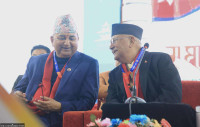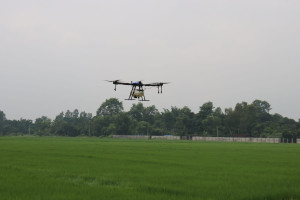Opinion
Path of mindfulness
Buddha’s teachings go beyond the formal concept of education that prevails in universities
Sandhya Regmi
The third International Buddhist Conference held in Kathmandu last month, followed by the 2560th Buddha Jayanti celebration in Lumbini, concluded with the 10-point Lumbini Declaration that seeks to promote Lumbini as the birthplace of Lord Buddha and the centre of Buddhist faith.
Being an admirer of Buddha’s teachings and philosophies, and as an artist of Buddha portraits, I felt privileged to take part in the conference. Venerable monks and nuns, archaeologists, scholars, artists, devotees and enthusiasts from over 32 countries as well as delegates from 28 countries participated in the conference which concluded on May 21.
Epicentre of world peace
The conference was special in many ways. Based on the archaeological evidence, historical facts and scientific principles, the event reaffirmed Lumbini as the birthplace of Buddha, origin of Buddhism and a site of world peace.
Presenting his research paper ‘New Archaeological Discoveries in Nepal’s Natal Landscape of the Buddha’, Professor Robin Coningham from UK’s Durham University concluded—based on the historical facts and their corroboration with other contemporary archaeological evidence—that Buddha was born in Lumbini. He spoke about the stone pillar that General Khadka Shamsher and Dr Anton Fuhrer had uncovered in Rumindei (modern day Lumbini) in 1896. The pillar has an inscription carved in early Brahmi script, which says that Ashoka came to worship there saying the Buddha was born there—confirming the site as the birthplace of Buddha.
Another research paper presented by Professor Anil Shakya from Thailand’s Mahamakut Buddhist University highlighted the fact that the inscription engraved on the Lumbini pillar in five lines consists of 93 Brahmi characters, which includes: ‘“Hidabhagavamjateti Lumminigame”: Lumbini village where the Buddha was born.’
Environmental concerns
The effective execution of the Lumbini Declaration is imperative, but that is where the challenge lies. An important agenda of the declaration is to accelerate the Lumbini World Peace City Master Plan. While funding and investment modalities are expected to play a critical role in shaping the process, other factors such as environmental concerns should not be ignored .
Lumbini should be free from environmental hazards. Currently, the main threat to Lumbini comes from the proliferating carbon-emitting factories, particularly, cement, brick and steel industries, around its periphery. The industrial emissions are putting both the social and natural environments—as well as the temples, monasteries and the 20th century Ashoka pillar—under serious threat of degradation.
A comprehensive air quality assessment conducted at the Lumbini World Heritage Site and its vicinity by the World Health Organisation (WHO) in 2013 revealed that the PM2.5 (fine particles) in the area touched an unhealthy level of 270 µg/m3—11 times higher than the WHO’s permissible level. The noise pollution too exceeds the standard magnitudes of 50 dB and 40 dB at day and night-time respectively. The amount of solid waste has also been increasing in Lumbini. As an environmental engineer, I am convinced that these conditions pose serious health hazards, especially respiratory and heart diseases for humans, as well as threats to biodiversity and ancient monuments.
Immediate and stringent legal measures should therefore be adopted by the government, line ministries and Lumbini Development Trust to remove all carbon-emitting industries established within the Lumbini Protected Zone, a 15km aerial distance from the Lumbini Project Area.
Furthermore, less polluting technologies, such as solar PV and electric vehicles, should be promoted inside the protected area.
Mecca for Buddhists
The government should also consider globalising Buddhist education system, as Bud-dhism’s unique characteristic is education and Buddha is synonymous with teaching.
The Lumbini declaration endorses the promotion of Lumbini as the hub of International Buddhist studies, with Lumbini Buddhist University as a centre for teaching excellence. Lumbini should be developed as an academic hub to cover studies and research on Buddhism. Besides, it should be made obligatory to include Buddha and his teachings in the curriculum of schools, ideally throughout the world. This would help enhance students’ sense of moral values.
Buddhist teachings go beyond the formal concept of education that prevails in universities and institutions, where one earns degrees mostly for pecuniary gain. In contrast, Buddha’s teachings have their own philosophy of holistic education that helps us understand the whole process of life through ‘inner intelligence’. They are solutions to ever-increasing human sufferings. Buddhism shows a secular and universal path to mankind in the most scientific manner to establish sustainable peace, happiness and prosperity. Albert Einstein once said, “If there is any religion that could respond to the needs of modern science, it would be Buddhism.”
Promoting Buddhist culture and heritage is equally important. To sustain Buddha’s teachings, we have to protect the historical sites, not just for our sake but also for future generations. Nepal should promote more academic studies, archaeological excavations, restoration and conservation works and scholarly engagement in Lumbini, Kapilvastu, Devdaha, Ramgram, Tilaurakot and other Buddha-related historico-religious places, and develop them as tourist destinations.
Besides, coordination among various nations is required to preserve and promote Buddhist temples, monasteries, pagodas, sculptures, libraries, museums and art galleries all over the world. Countries should realise that all it takes is commitment, political will and necessary funds to preserve Buddhism in all its forms.
More interaction, communication and events in collaboration with the international community are needed. This could include seeking the UN’s endorsement to celebrate Buddha Jayanti and organise an annual international Buddhist conference in Nepal. It would help develop Lumbini as the Mecca for Buddhists.




 7.12°C Kathmandu
7.12°C Kathmandu










